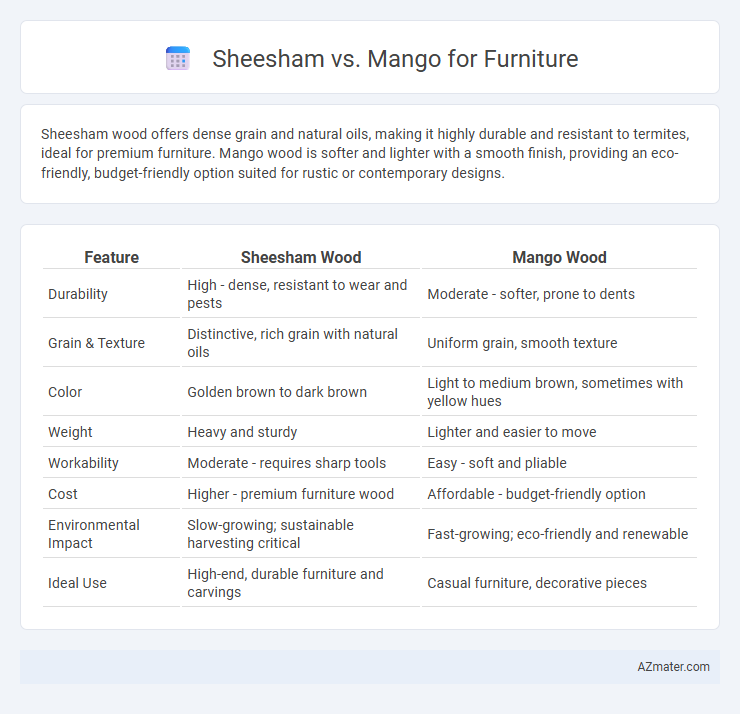Sheesham wood offers dense grain and natural oils, making it highly durable and resistant to termites, ideal for premium furniture. Mango wood is softer and lighter with a smooth finish, providing an eco-friendly, budget-friendly option suited for rustic or contemporary designs.
Table of Comparison
| Feature | Sheesham Wood | Mango Wood |
|---|---|---|
| Durability | High - dense, resistant to wear and pests | Moderate - softer, prone to dents |
| Grain & Texture | Distinctive, rich grain with natural oils | Uniform grain, smooth texture |
| Color | Golden brown to dark brown | Light to medium brown, sometimes with yellow hues |
| Weight | Heavy and sturdy | Lighter and easier to move |
| Workability | Moderate - requires sharp tools | Easy - soft and pliable |
| Cost | Higher - premium furniture wood | Affordable - budget-friendly option |
| Environmental Impact | Slow-growing; sustainable harvesting critical | Fast-growing; eco-friendly and renewable |
| Ideal Use | High-end, durable furniture and carvings | Casual furniture, decorative pieces |
Sheesham vs Mango: An Overview
Sheesham wood, known for its durability and rich grain patterns, offers superior strength compared to Mango wood, which is softer and more affordable. Sheesham is highly resistant to rot and insects, making it ideal for long-lasting furniture, whereas Mango wood is more prone to scratches but favored for its eco-friendly properties and lighter weight. Both woods deliver unique aesthetics; Sheesham's deep, warm tones contrast with Mango's lighter, varied hues, influencing their suitability for different furniture styles.
Wood Characteristics: Sheesham vs Mango
Sheesham wood, known for its rich, dark grain patterns and high durability, offers excellent resistance to decay and termite attacks, making it ideal for long-lasting furniture. Mango wood is lighter with a softer texture and more uniform grain, providing better workability but lower hardness and durability compared to Sheesham. Both woods are sustainable choices, but Sheesham's density and natural oils provide superior strength and resistance, while mango wood's affordability and ease of finishing appeal for decorative pieces.
Durability and Strength Comparison
Sheesham wood, also known as Indian rosewood, offers superior durability and strength compared to mango wood, making it ideal for heavy-use furniture. Sheesham's dense grain structure provides resistance to scratches and dents, ensuring long-lasting performance. Mango wood, while eco-friendly and cost-effective, has a softer texture that may wear faster under constant pressure, limiting its suitability for high-traffic furniture pieces.
Aesthetic Appeal and Grain Patterns
Sheesham wood features rich, dark brown hues with striking, wavy grain patterns that enhance the aesthetic appeal of furniture by adding depth and natural elegance. Mango wood offers lighter tones with a more uniform and subtle grain, providing a warm, rustic charm suitable for contemporary and casual designs. The distinctive grain complexity of Sheesham makes it ideal for statement pieces, while Mango's smooth texture complements minimalist and everyday furniture styles.
Resistance to Pests and Decay
Sheesham wood, also known as Indian rosewood, exhibits superior resistance to pests and decay due to its natural oils, making it an ideal choice for durable furniture in humid or termite-prone environments. Mango wood, while eco-friendly and sustainable, is softer and more susceptible to insect damage and rot without proper treatment. Choosing Sheesham ensures longer-lasting furniture with minimal maintenance against biological deterioration compared to Mango wood.
Environmental Impact and Sustainability
Sheesham wood, known for its durability and natural resistance to insects, is often sourced from mature trees, which raises concerns about deforestation and habitat loss if not harvested sustainably. Mango wood, derived from fast-growing, fruit-bearing trees primarily cultivated for mango production, is generally considered more sustainable as it uses timber from trees that have reached the end of their fruit-bearing cycle, reducing waste. Choosing mango wood furniture supports responsible forestry practices and promotes environmental conservation, whereas sheesham requires careful sourcing to minimize ecological impact.
Cost and Availability
Sheesham wood is generally more expensive than mango wood due to its durability and premium quality, making it a preferred choice for high-end furniture. Mango wood is more affordable and widely available, often used for budget-friendly and eco-friendly furniture options. Availability of Sheesham can be limited depending on the region, while mango wood is more commonly found worldwide.
Maintenance Requirements
Sheesham wood requires regular polishing and oiling to maintain its natural sheen and prevent dryness, making its maintenance moderately high compared to Mango wood. Mango wood demands less frequent upkeep, as it is naturally resistant to pests and can be cleaned easily with a damp cloth, ideal for low-maintenance furniture. Durability and sustainability of Sheesham make it suitable for long-term investment despite its higher care needs, whereas Mango is better for budget-friendly, low-maintenance options.
Best Uses for Each Wood in Furniture
Sheesham wood is highly durable and naturally resistant to termites and decay, making it ideal for heavy-use furniture like cabinets, beds, and dining tables. Mango wood, known for its sustainability and attractive grain patterns, excels in creating lightweight furniture pieces such as chairs, side tables, and decorative items. Both woods offer unique aesthetics: Sheesham's rich, dark finish suits traditional or rustic styles, while Mango's lighter tones and varied textures complement contemporary or eclectic designs.
Which is Better: Sheesham or Mango for Furniture?
Sheesham wood offers greater durability and natural resistance to termites and decay, making it ideal for long-lasting furniture with intricate grain patterns that enhance aesthetic appeal. Mango wood, while more affordable and eco-friendly due to its fast growth, tends to be softer and less resistant to moisture, making it better suited for decorative pieces or light-use furniture. Choosing Sheesham over Mango ensures sturdier, premium-quality furniture, whereas Mango serves well for budget-conscious buyers seeking sustainable options.

Infographic: Sheesham vs Mango for Furniture
 azmater.com
azmater.com